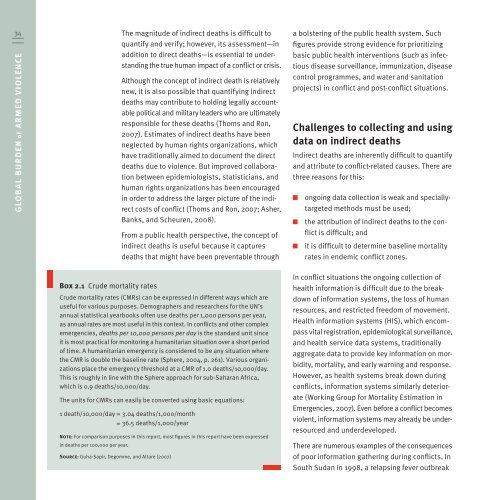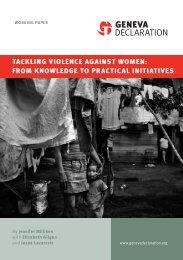Global Burden of Armed Violence - The Geneva Declaration on ...
Global Burden of Armed Violence - The Geneva Declaration on ...
Global Burden of Armed Violence - The Geneva Declaration on ...
You also want an ePaper? Increase the reach of your titles
YUMPU automatically turns print PDFs into web optimized ePapers that Google loves.
34 <str<strong>on</strong>g>The</str<strong>on</strong>g> magnitude <str<strong>on</strong>g>of</str<strong>on</strong>g> indirect deaths is difficult to<br />
quantify and verify; however, its assessment—in<br />
additi<strong>on</strong> to direct deaths—is essential to understanding<br />
the true human impact <str<strong>on</strong>g>of</str<strong>on</strong>g> a c<strong>on</strong>flict or crisis.<br />
GLOBAL BURDEN <str<strong>on</strong>g>of</str<strong>on</strong>g> ARMED VIOLENCE<br />
Box 2.1 Crude mortality rates<br />
Although the c<strong>on</strong>cept <str<strong>on</strong>g>of</str<strong>on</strong>g> indirect death is relatively<br />
new, it is also possible that quantifying indirect<br />
deaths may c<strong>on</strong>tribute to holding legally accountable<br />
political and military leaders who are ultimately<br />
resp<strong>on</strong>sible for these deaths (Thoms and R<strong>on</strong>,<br />
2007). Estimates <str<strong>on</strong>g>of</str<strong>on</strong>g> indirect deaths have been<br />
neglected by human rights organizati<strong>on</strong>s, which<br />
have traditi<strong>on</strong>ally aimed to document the direct<br />
deaths due to violence. But improved collaborati<strong>on</strong><br />
between epidemiologists, statisticians, and<br />
human rights organizati<strong>on</strong>s has been encouraged<br />
in order to address the larger picture <str<strong>on</strong>g>of</str<strong>on</strong>g> the indirect<br />
costs <str<strong>on</strong>g>of</str<strong>on</strong>g> c<strong>on</strong>flict (Thoms and R<strong>on</strong>, 2007; Asher,<br />
Banks, and Scheuren, 2008).<br />
From a public health perspective, the c<strong>on</strong>cept <str<strong>on</strong>g>of</str<strong>on</strong>g><br />
indirect deaths is useful because it captures<br />
deaths that might have been preventable through<br />
Crude mortality rates (CMRs) can be expressed in different ways which are<br />
useful for various purposes. Demographers and researchers for the UN’s<br />
annual statistical yearbooks <str<strong>on</strong>g>of</str<strong>on</strong>g>ten use deaths per 1,000 pers<strong>on</strong>s per year,<br />
as annual rates are most useful in this c<strong>on</strong>text. In c<strong>on</strong>flicts and other complex<br />
emergencies, deaths per 10,000 pers<strong>on</strong>s per day is the standard unit since<br />
it is most practical for m<strong>on</strong>itoring a humanitarian situati<strong>on</strong> over a short period<br />
<str<strong>on</strong>g>of</str<strong>on</strong>g> time. A humanitarian emergency is c<strong>on</strong>sidered to be any situati<strong>on</strong> where<br />
the CMR is double the baseline rate (Sphere, 2004, p. 261). Various organizati<strong>on</strong>s<br />
place the emergency threshold at a CMR <str<strong>on</strong>g>of</str<strong>on</strong>g> 1.0 deaths/10,000/day.<br />
This is roughly in line with the Sphere approach for sub-Saharan Africa,<br />
which is 0.9 deaths/10,000/day.<br />
<str<strong>on</strong>g>The</str<strong>on</strong>g> units for CMRs can easily be c<strong>on</strong>verted using basic equati<strong>on</strong>s:<br />
1 death/10,000/day = 3.04 deaths/1,000/m<strong>on</strong>th<br />
= 36.5 deaths/1,000/year<br />
Note: For comparis<strong>on</strong> purposes in this report, most figures in this report have been expressed<br />
in deaths per 100,000 per year.<br />
Source: Guha-Sapir, Degomme, and Altare (2007)<br />
a bolstering <str<strong>on</strong>g>of</str<strong>on</strong>g> the public health system. Such<br />
figures provide str<strong>on</strong>g evidence for prioritizing<br />
basic public health interventi<strong>on</strong>s (such as infectious<br />
disease surveillance, immunizati<strong>on</strong>, disease<br />
c<strong>on</strong>trol programmes, and water and sanitati<strong>on</strong><br />
projects) in c<strong>on</strong>flict and post-c<strong>on</strong>flict situati<strong>on</strong>s.<br />
Challenges to collecting and using<br />
data <strong>on</strong> indirect deaths<br />
Indirect deaths are inherently difficult to quantify<br />
and attribute to c<strong>on</strong>flict-related causes. <str<strong>on</strong>g>The</str<strong>on</strong>g>re are<br />
three reas<strong>on</strong>s for this:<br />
<strong>on</strong>going data collecti<strong>on</strong> is weak and speciallytargeted<br />
methods must be used;<br />
the attributi<strong>on</strong> <str<strong>on</strong>g>of</str<strong>on</strong>g> indirect deaths to the c<strong>on</strong>flict<br />
is difficult; and<br />
it is difficult to determine baseline mortality<br />
rates in endemic c<strong>on</strong>flict z<strong>on</strong>es.<br />
In c<strong>on</strong>flict situati<strong>on</strong>s the <strong>on</strong>going collecti<strong>on</strong> <str<strong>on</strong>g>of</str<strong>on</strong>g><br />
health informati<strong>on</strong> is difficult due to the breakdown<br />
<str<strong>on</strong>g>of</str<strong>on</strong>g> informati<strong>on</strong> systems, the loss <str<strong>on</strong>g>of</str<strong>on</strong>g> human<br />
resources, and restricted freedom <str<strong>on</strong>g>of</str<strong>on</strong>g> movement.<br />
Health informati<strong>on</strong> systems (HIS), which encompass<br />
vital registrati<strong>on</strong>, epidemiological surveillance,<br />
and health service data systems, traditi<strong>on</strong>ally<br />
aggregate data to provide key informati<strong>on</strong> <strong>on</strong> morbidity,<br />
mortality, and early warning and resp<strong>on</strong>se.<br />
However, as health systems break down during<br />
c<strong>on</strong>flicts, informati<strong>on</strong> systems similarly deteriorate<br />
(Working Group for Mortality Estimati<strong>on</strong> in<br />
Emergencies, 2007). Even before a c<strong>on</strong>flict becomes<br />
violent, informati<strong>on</strong> systems may already be underresourced<br />
and underdeveloped.<br />
<str<strong>on</strong>g>The</str<strong>on</strong>g>re are numerous examples <str<strong>on</strong>g>of</str<strong>on</strong>g> the c<strong>on</strong>sequences<br />
<str<strong>on</strong>g>of</str<strong>on</strong>g> poor informati<strong>on</strong> gathering during c<strong>on</strong>flicts. In<br />
South Sudan in 1998, a relapsing fever outbreak









